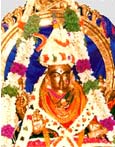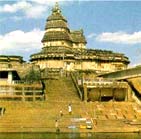|
Place of interest |
Sarada Temple: |
 |
The Saradamba temple is constructed in the modern Dravidian style, with a gopuram
at the entrance, and broad covered walkways for pradakshina. The beautiful image of
the Goddess can be seen from the distance as one enters the temple from the main gopuram.
She is seated on the Sriyantra on a golden throne, inside the garbha-griha,
which is made of polished granite. In front of Her Sanctum is a spacious hall supported by
pillars with exquisite carvings on them. Within the temple of Saradamba is kept the Vyakhyana
Simhasanam, which represents the sarvajna-pitha, the throne of transcendental
wisdom. The Acharyas ascend this simhasanam when they are first initiated into
sannyasa, when they take charge at the matha, and also on |
|
ceremonial occasions like the nine days of the Navaratri festival.
The deity of Sriyantra is generally said to be Lalita Sri Rajarajeshwari who is not
different from Sarada. Sankara addresses the devi as Chidananda Lahari (a wave of
consciousness and bliss ).
In Sarada the aspect is on the chit aspect while in Lalita Raja Rajeshwari it is on the
ananda aspect. The figure and conception of Sri Sarada are quite charecteristic of the
philosophical teaching of Sri Sankaracharya.
The temple of Sri Sarada originally consisted of a Yantra carved on a rock in the middle
of the Tunga river by Sri Sankaracharya,with a sandlewood image installed on it and
covered by a thatched roof.The present golden image dates from the time of Sri Vidyaranga,
the Acharya who added the luxury of a tiled roof.The tiled building existed till about
1907 when the 33rd Acharya decided to have a more substantial building erected in its
place.The work began but was unfinished at the time of his siddi.His successor later
completed the construction.The Kumbhabhisheka was duly performed in the year 1916 with
grandeur and enthusiasm.The event was graced by the presence of His Highness the Maharaja
of Mysore.
Sri Sarada with her beaming countenance sparkling eyes and bewitching smile sends a thrill
of joy through the hearts of the devotees. She remains true to her promise to be ever
immanent there. Her living presence infuses awe and reverence in the minds of all devotees
and guides the destinies of the matha,which was entrusted to her care by Sri
Sankaracharya, to spread far and wide the truths of advata. The devout worship performed
to her by the illustrious acharyas, who have adorned Sringeri matha since her
consecrationhas sustained and augmented the splendor of her divine manifestation.
During all these centuries the godess has filled the Sringeri Matha with the aura and
afflatus of her divine presence, to inspire and guide the actions of the Achryas.
Sarada is Guru Rupini – she is of the form of the guru. Through the person of the
Jagadguru she dispenses her grace.
Sarada who represents the saguna form of the supreme absolute is the great matrix of the
universe displaying in her hands the symbol of the jar full of nectar of immortality, a
book signifying supreme knowledge ,a rosary the beads of which signify then subtle
aksharas or bijas from which the gross forms of the universe emanate, and the chinmudra
standing for the awareness of the identity of the jiva with the brahman. She is the light
of all upanishadic knowledge and as such is brahmavidya.
God head conceived as absolute truth has to transcend the idea of any kind of limitation
including that of sex. Except our own mistaken habits of thought, there is really no
justification for the popular conception of god as he. God may with equal justice and
propriety, be considered she. Such an ideal is Sri Sarada. She transcends the three
qualified conceptions, known as Trimurtis, and their corresponding Saktis known as Saraswati, Lakshmi and Iswari. She encompasses all these. This accounts for the fact that
Sri Sarada reigns alone in the temple at Sringeri. She is also called Sarada Parameswari
and pooja is done reciting the Lalithasahasranamam.
It is usual in other temples in which the devi is principal deity to have a Sivalinga or
other murti to represent the shaktiman, the wielder of Shakti. but Sri Sarada is both
Sakti, the power and Shaktiman the wielder of that power, so there is no need for a
separate linga or murti to represent the wielder. This accounts also for the seemingly
contradictory contexts in the stotras of the Acharyas when they address her sometimes as Saraswati, and sometimes as Iswari.
Other instances attribute to her the specific features of the three Saktis and sometimes
of the Trimurtis as well. When Sankara established his matha at Sringeri, he first built
four guardian temples on the surrounding hillocks which were to protect the village from
dangers, diseases and the forces of evil. On the eastern hillock, he built a temple for
kalabhairava, on the west for anjaneya, on the south for durga, and on the north for kali.
Poojas are still being performed at these temples.
|
The Vidyasankara Temple: |
The Vidyasankara temple was built in the 14th century, by
Sri Bharati Tirtha (I) and Sri Vidyaranya. The temple commemorates the memory of their
guru, Sri Vidyatirtha, also known as Vidyasankara.
There is an interesting legend attached to the foundation of this temple. After
entrusting the Sringeri matha to his successor, Sri Bharati Tirtha (I), Sri Vidyasankara
entered into a special kind of yogic sadhana called lambika yoga,
and predicted that his body would assume the form of the Chaturmurti Vidyesvara sculpture,
if left undisturbed for 12 years. This sculpture is now seen in Simhagiri, a village near
Sringeri. The sculpture shows Vidyasankara attended by |

|
|
his disciples, Bharati Tirtha and Vidyaranya at the base, on top of which there
is a carving of Yoga Narasimha. A Sivalinga tops the sculpture. Unfortunately, some
curious attendant opened the meditation room, and only the top Sivalinga was found. This
disturbed everybody at the matha, but Sri Vidyasankara appeared in a dream
to Sri Bharati Tirtha and told him not to worry, although the predicted effect
would not take place. Sri Bharati Tirtha and Vidyaranya then had the Vidyasankara temple
constructed with this Sivalinga in the sanctum Sri Vidyasankara is still believed to be
present in the sanctum of the temple, and so the official seal of the Sringeri Matha is
still in his name. The Sringeri Sankaracharyas are therefore known by the title .
|

|
The Vidyasankara temple is historically very important, as it was built during
the beginning of the glorious Vijayanagar empire which ruled all of southern India for a
long period of time. Some of the earliest inscriptions of the Harihara I and Bukka, the
founders of the Vijayanagar empire are found in this temple. Therefore, the temple was
taken under the protection of the Archaeological Survey of India in 1951. |
|
It is a unique monument built completely of stone.It is unique because it combines both
Hoysala and Dravida architectural features.The outline of the vimana and the presence of a
sukhansai with a superstructure are the chief Hoysala features.
The tiers in the vimana and the formation of the pillars in the front mandapa are
characteristically Dravidian.The structure which stands on a raised plinth at the loop of
the river and commands a magnificient view from the hills and their loops all around, is
more or less a rectangle with apsidal east-west ends.In the western half is the
garbhagriha with its sukhansi;on the other side of the latter is a shrine of Vidya
Ganapathi in the south and of Mahisha-Mardini in the north,each with a ardha mandapa in
the front.
In the eastern half of the structure is a mandapa with twelve pillars,huge
monoliths of a composite character carrying large animal figures on their fronts. There
are twelve pillars in the outer hall of the temple, each representing one sign of the
zodiac. The pillars are positioned in such a way that the sunlight entering through the
eastern door falls upon the pillar representing the sign of the zodiac that the sun is
currently in. The pillars also have heads of lions carved on each side, with stone balls
in their mouths. These balls can be freely rotated but not taken out. Various other
sculptures, including Lord Siva as Nataraja, and Buddha as an incarnation of Lord Vishnu
are found on the temple walls.
|
Top |
|